
94% of researchers rate our articles as excellent or good
Learn more about the work of our research integrity team to safeguard the quality of each article we publish.
Find out more
ORIGINAL RESEARCH article
Front. Earth Sci., 04 April 2023
Sec. Marine Geoscience
Volume 11 - 2023 | https://doi.org/10.3389/feart.2023.982482
 Wenwen Chen1
Wenwen Chen1 Junhui Xing2,3*
Junhui Xing2,3*Submarine landslides, one of the hotspots in marine geoscience research, are one of the most harmful marine geological disasters. To understand the research status and further research directions of submarine landslides, this paper analyzed the global submarine landslide-related work during the period from 2001 to 2020. To achieve this objective, Science Citation Index Expand and the Social Sciences Citation Index, belonging to the WoS Core Collection, were the two bibliographic databases selected as a reference. In this study, we focused on document types, publishing languages, subject categories, journals’ productivity, countries and author, and co-occurrence keywords network. Geoscience multidisciplinary, Geochemistry Geophysics, Oceanography, Environmental Sciences, and Materials Science Multidisciplinary have been the most commonly used science categories in the past two decades. Marine Geology, Marine and Petroleum Geology, Journal of Volcanology, and Geothermal Research are the three most productive journals on submarine landslides. Marine Geology is the most active journal among all the journals. The United States, the United Kingdom, China, Germany, and France are the five most productive countries. At the institutional level, the Centre National De la Recherche Scientifique (France) is the most active institution, followed by the Chinese Academy of Sciences (China) and Helmholtz Association (Germany). Masson DG and Talling PJ from the United Kingdom contribute to the most high-quality submarine landslide-related publications. Analyzing by CiteSpace, the five largest clusters in the submarine landslide field are “gas hydrate,” “turbidity current,” “thin film,” “debris avalanche,” and “submarine canyon.” Active further research directions of submarine landslides are “south china sea,” “slump,” and “submarine mass failure.”
Submarine landslides are a type of marine landslide, a general term that refers to the downward or outward mass movement of sea floor sediments (e.g., Hampton et al., 1996; Locat and Lee, 2002; Masson et al., 2006). On the basis of the wide sea area, large depth, diverse topography, structural conditions, and hydrodynamic conditions, submarine landslides are different from landslides on land in formation environment, development scale, occurrence mechanism, and movement mode (e.g., Heidarzadeh et al., 2014; Zhu et al., 2015; Ye, 2017). In the 1960s, researchers increased their attention to submarine landslides and focused on submarine slope failure and mass movement by using seafloor topography. Since the development of seismic techniques, submarine landslide topics discussed in the literature have tended to have specific academic interests, for instance, their role in the evolution of the submarine landscape and as a cause of tsunamis (e.g., Hampton et al., 1996; Fu et al., 2017).
With the increasing thoroughness of the process of exploration and development of the ocean, the large-scale development of marine oil and gas resources, and the rapid development of various marine engineering construction, the study of seabed geological disasters has become increasingly notable. Many types of submarine geological disasters exist, and more than 20 types have been found, such as submarine landslides, deep-water “three shallow” (i.e., shallow gas, shallow water flow, and gas hydrate) geological disasters, earthquakes, tsunamis, and sea level changes (Wu et al., 2021). Submarine landslide is one of the most harmful marine geological disasters and is closely related to other marine geological disasters. Therefore, the submarine landslide has become one of the hotspots in marine geoscience research.
Bibliometrics is based on literature as the research object. It mainly employs quantitative statistical analysis, statistical literature quantity change, distribution, and change law and is widely used in scientific research evaluation and discipline or research field status, hotspot, and trend analysis (Hu and Zhang, 2021). The use of bibliometric analysis to analyze a certain field of geoscience for studying the development and Frontier hotspots in this field has been increasing (Zhang et al., 2016; Li, 2017; Zhu et al., 2018). Today, many studies are focusing on the analysis of global landslide research. For example, Gokceoglu and Sezer analyzed the quantity change, journals, and keywords of global landslide literature from 1945 to 2008 (Gokceoglu and Sezer, 2009). Wu et al. (2015) analyzed the development trend, main publications, and keywords of global landslide literature from 1991 to 2014. Sassa et al. (2015) analyzed papers published in Landslides from 2009 to 2013. However, few studies have focused on submarine landslides using the bibliometric method.
In this paper, on the basis of the Web of Science (WoS) Core Collection database, we perform a statistical analysis of the publication metadata on submarine landslide research from 2001 to 2020. We mainly focus on 1) several aspects of the publications on submarine landslides, including the type and languages of documents, the trend of publications and citations; 2) the output co-occurrence of subject categories, countries, journals, and authors; 3) research status and future research directions of submarine landslides according to the co-occurrence of keywords network to investigate. This work provides a reference for global scholars to refine their research objectives and follow-up research in the submarine landslides field.
All publications are from the Science Citation Index Expanded (SCIE) and Social Sciences Citation Index (SSCI), which belong to the WoS Core Collection database (https://www.webofscience.com/wos/alldb/basic-search). The SCIE and SSCI databases are the most important, influential, comprehensive, and selective collections covering the sciences. A series of terms, namely, “submarine landslides*,” “submarine mass movement*,” “mass-transport deposits*,” “submarine slope failure*,” “submarine slope instability*,” and “submarine hazard*” were used to search for all publications that contained those words in the title, abstract, and keywords. As a result of this search, 6,111 publications from 2001 to 2020 were identified. To avoid possible fake results, we analyzed the publications in the search manually one by one. Ultimately, our results contained 5,831 records from 2001 to 2020, which were downloaded on 25 November 2021. We used these records as the research object of this paper. Although the data collected do not cover all relevant literature, a large dataset and a highly recognized database are representative.
In this paper, we conducted a series of analyses, for example, the number of publications and citations per year and the number of document types, by using MS Excel and Golden Grapher. Additionally, two types of software are commonly used in the bibliometric analysis. One type is VoSviewer (VOS). It was developed by Nees Jan van Eck and Ludo Waltman at Leiden University’s Center for Science and Technology Studies in 2007 (Van Eck and Waltman, 2007; https://www.vosviewer.com). VOS presents the structure, law, and distribution of scientific knowledge through the visualization method. The other type is CiteSpace, designed as a tool for progressive knowledge domain visualization by Chen. (2004) (http://cluster.cis.drexel.edu/∼cchen/citespace/). CiteSpace uses nodes to evaluate the research directions and hotspots in a field. The two types of software provide scientific research perspectives from different aspects. Therefore, the journal and author bibliographic coupling and the co-occurrence of journals and country are assessed using VOS software (Version 1.6.16). Our keyword analysis used publications’ keywords as analysis objects, which use CiteSpace 5.8.R3.
In this study, papers published from England, Northern Ireland, Scotland, and Wales were reclassified as derived from the United Kingdom (UK), and papers published from Mainland China and Taiwan were reclassified as China.
From 2001 to 2020, 5,831 publications of 10 types were retrieved according to WoS. “Articles” (5,551) is the main type, accounting for 95.2% of the total number of publications (Figure 1A). “Proceeding Papers” and “Review Articles” accounts for 4.8% (281) and 4.1% (239) of the total number of publications, respectively. Other types of papers are “Editorial Materials,” (31 publications, 0.5%) “Book Chapters,” (6) “Corrections,” (6) “Letters,” (3) “Early Access (2),” “Retracted Publications,” (2) and “Reprints” (1).
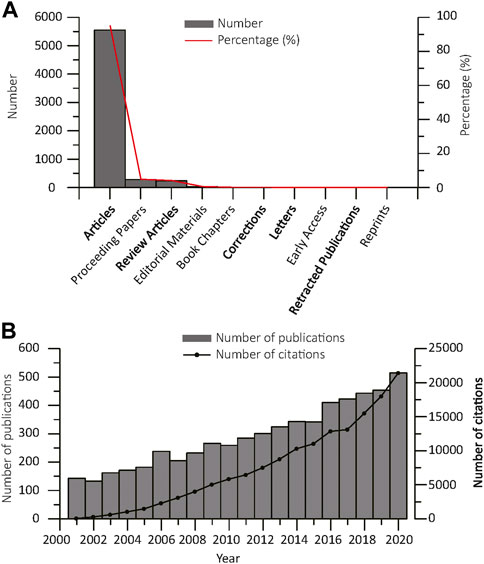
FIGURE 1. (A) Document type in the field of submarine landslides from 2001 to 2020; (B) Number of publications and total citations on submarine landslide research from 2001 to 2020. Gray bars represent the number of publications. The dark line represents the number of citations.
Ten publishing languages are among the publications from 2001 to 2020. The predominant language of the collected records is English (99.3%). Chinese (19, 0.3%) and Spanish (9, 0.1%) account for a relatively small proportion of the publications. The remaining languages are French (5), German (3), Polish (3), Italian (2), Russian (1), Turkish (1), and Unspecified (1).
The total number of publications in the field of submarine landslide demonstrates a significant increase from 143 in 2002 to 515 in 2020. The average annual growth rate is approximately 7.5% but is uneven (Figure 1B). From 2001 to 2010, the number of publications fluctuates: three small drops occur, one each in 2002, 2007, and 2010. In the subsequent years, the number of publications increases steadily. The number of citations shows a similar trend to that of publications. The number of citations is 49 in 2001, which is relatively lower than in the remaining years. Since 2003, the number of citations has increased from 273 to 21,413, with an average annual growth rate of approximately 24%, except for that of 121% in 2003. However, the declining trend in the annual citations in our study and that by Wu et al. (2015) do not differ, indicating that the old and recent publications related to submarine landslides are cited very frequently.
The outputs beyond the aforementioned aspects are summarized in Table 1. The authors in the articles increase from 451 to 2,637 over the entire study period. This increase indicates that the research on submarine landslides has received increasing attention from 2001 to 2020. A similar decrease in the number of total authors occurred in 2007, which is consistent with the trend in the number of publications. The average author per publication increased from 3.2 at the beginning of the 20-year period to 5.1 at the end of it, indicating that cooperation in the research field of submarine landslides has increased. Furthermore, the citation per publication increases from 0.3 to 41.6 during the entire period. These data reveal that the research related to submarine landslides has become increasingly important and complex and that the cooperation among scientists has increased.
In the WoS, journals can be assigned to several subject categories. The number of categories related to the field submarine landslide fluctuates from 48 in 2004 to 67 in 2020, with a peak of 75 in 2016, over the entire period. This finding indicates that submarine landslides research is a typical type of interdisciplinary research and involves numerous disciplinary areas. In this study, five productive categories are shown in Figure 2. Geosciences Multidisciplinary ranks first place, accounting for 2017 records (34.6% of total publications). The number of publications in Geosciences Multidisciplinary rapidly increases with an average annual growth rate of 10.6%. Four peaks are observed: one each in 2005, 2009, 2018, and 2020. Furthermore, three obvious decreases are observed—one each in 2003, 2007, and 2017—and the other four categories slightly increase. The other four most productive categories are Geochemistry Geophysics (732, 12.6%), Oceanography (711, 12.2%), Environmental Sciences (524, 9.0%), and Materials Science Multidisciplinary (451, 7.3%). Compared with Geosciences Multidisciplinary, all four categories increase steadily and change over the entire period, implying that the interest of scientists in the four categories changed over time. The single-subject research category has been unable to understand submarine landslides effectively, and multidisciplinary research has become the research trend. These five groups cover approximately 76% of research articles related to submarine landslides, indicating that the studies on submarine landslides are involved in a wider range of science categories.
During the past two decades (2001–2020), submarine landslide-related articles have been published in 1,080 journals. The number of journals related to submarine landslides fluctuates from 91 in 2002 to the highest number, 250, in 2020. The top 20 most productive journals in publications are listed in Table 2. The publications in these journals (8% of all journals) account for approximately 1718 publications and 29.48% of all records, revealing the importance of these journals in the field of submarine landslide. Marine Geology has 327 articles, accounting for 5.608% of the total articles and ranking first place. It is followed by Marine and Petroleum Geology (182, 3.121%), Journal of Volcanology and Geothermal Research (100, 1.715%), Geomorphology (91, 1.561%), and Journal of Geophysical Research-Solid Earth (90, 1.543%). In this study, we show the article impact factor (AIF), which is calculated as the number of citable items in 2018 and 2019 divided by citations in 2020 to items published in 2018 and 2019 (Table 2). A linear relationship between AIF and IF, calculated by the WoS, was (R2 = 0.633), revealing that the submarine landslide-related articles provide a significant contribution to the journal’s IF. This result is consistent with that of Wu et al. (2015). The annual number of publications for the top five most productive journals shows that the number of publications of Marine Geology ranks first place in most years, except for 2001, 2013, and 2018–2020 (Figure 3). The annual number of publications of Marine and Petroleum Geology increase rapidly over the entire period and have exceeded those of Marine Geology from 2018 to 2020). The number of publications of the remaining three journals fluctuates steadily, and they exchange their relative rank several times over the entire period. However, although the average citations per article of the top three journals are relatively higher than that of all other journals, the journal with the highest average citations per article is Journal of Geological Research: Solid Earth (42.94), followed by Geology (42.17) and Earth and Planetary Science Letters (41.34). This finding indicates that these journals have a certain influence on the study of submarine landslides.
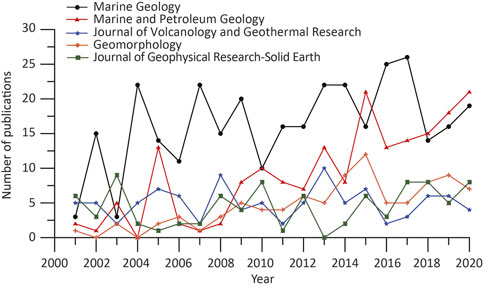
FIGURE 3. Annual significance of the top five most productive journals on submarine landslides, 2001–2020.
The H-index value is based on a list of publications ranked in descending order by the times cited count. An index of H means H papers have each been cited at least H times. The highest H-index is for Marine Geology (53); thus, among the journals, Marine Geology published the highest quality submarine landslide-related articles.
To improve the understanding of the relationship among the items, e.g., journals, authors, and countries, researchers have used bibliography coupling via VOSviewer software for analysis (e.g., Gizzi and Leucci, 2018; Fan et al., 2020). Figure 4 shows the occurrence among the top 21 most productive journals observed in this study. The minimum number of documents of a source (journal) is 50. Each journal is represented by a node. In general, the distance between each node indicates the strength of the relationship with other journals. It demonstrates that the shorter the distance, the stronger relationship. Furthermore, the thicker the lines, the stronger the links. In addition, the higher the weight of an item, the larger its node/circle. The color of an item is determined by the cluster to which the item belongs (van Eck and Waltman, 2007). In this study, four clusters with different colors are identified. The same color denotes a relatively strong connection, providing evidence that the same cluster manages comparable topics. Cluster size ranges from 1 to 10 journals. Clusters 1 (4) with red (yellow) nodes have 10 (1) journals. Clusters 2 and 3 have five journals each and are labeled in green and blue, respectively. According to the thickness and distance of the link lines, as well as the size of the node, Marine Geology plays an important role in the bibliography coupling network. Clusters 1, 2, and 4 contain journals that published articles mainly on geoscience multidisciplinary, geochemistry, and geophysics. Science of the Total Environment and Electrochimica Acta is far from other journals, indicating that published articles on electrochemistry and environmental science are relatively less cited in, for example, geoscience multidisciplinary, geology, and oceanography categories.
In this study, from the national perspective, an increased number of countries accompany an increased number of publications on submarine landslide-related research. During the entire period, the number of countries that worked in this field ranges from 58 to 126; the peak (126) was in 2020. Table 3 lists the top 20 most productive countries in this field with essential information (e.g., total publications, total citations, and H-index). Among the 20 countries, 11 countries are from Europe, four countries are from Asia, and the remaining countries are from North America (2), South America (1), and Oceania (2). The United States (United States) ranks first place with 1703 publications (29.206%), followed by the United Kingdom (914 publications) and China (812 publications). An obviously significant gap between first place (United States) and second place (United Kingdom) indicates that the United States holds the leadership role among the top 20 countries. In Table 3, although the H-index of China (59) is relatively high, the citation per article in China (21.85) is lower than that of most countries, indicating that its researchers should focus on improving research quality.
Figure 5 shows the annual trend of the top 10 most productive countries. Before 2018, the number of US publications is higher than that of other top 10 most productive countries. From 2001 to 2016, the United Kingdom ranks second in the number of publications. Since 2011, the number of publications from China in this field has sharply increased, and in 2017 and 2018, the number of publications from China exceeds that of the United Kingdom and the United States, respectively. We posit that the Fukushima nuclear disaster, triggered by a tsunami in Japan in 2011, increased China’s awareness of the urgency of studying submarine landslides. Since then, China’s strategy for marine research since 2012 and its key study on natural gas hydrate in the South China Sea in approximately 2017 have played an important role in submarine landslide research. China ranks first in recent years in average annual growth rate, with 23.6% over the past decade. The number of other seven countries does not increase significantly.
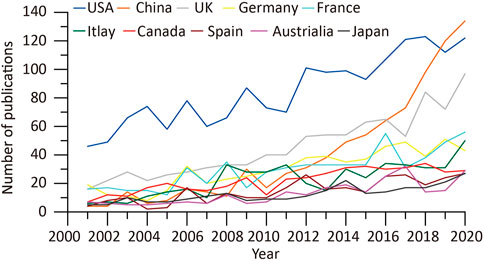
FIGURE 5. Annual significance of the top 10 most productive countries on submarine landslides, 2001–2020.
Figure 6 shows the co-authorship among the top 20 most productive countries, where the nodes denote the country, size, and total number of articles by country, and line thickness demonstrates the strength of the relationship between the two countries. The minimum number of documents for a country is 84. The United States and the United Kingdom are the two biggest nodes, and they have collaborated with all the top countries, showing that the United States and the United Kingdom play a key role in the cooperation network because they are the primary collaborators among the top productive countries (Figure 6A). Three clusters are observed in Figure 6A. Cluster 1 has 11 countries with a red node, which are all from Europe, and cluster 2 has seven countries with a green node, which are from the United States and Asia. The remaining two countries from Oceania are identified in cluster 3, denoted by blue nodes. In the co-occurrence map, the thickness of the lines between two countries represents the close degree of cooperation between them. The thicker and shorter the lines, the closer the cooperation between two countries. In the field of submarine landslide research, the most closely cooperative entities are United States–United Kingdom, United States–Germany, United Kingdom–Germany, China–United States, United States–Canada, and France–3United Kingdom. Figure 6B shows the overlay visualization of the co-authorship, which is identical to the network visualization. The color of an item is determined by the score (average appearance time), where—by default—colors range from blue (lowest score) to green to yellow (highest score). At the early stage of the entire study period, the international cooperation is among the United States, Canada, France, and Norway, revealing that early attention to this field was from these countries (Figure 6B). Furthermore, the international cooperation from China starts later than that of most of the top countries, but the process of global collaboration in China is progressing quickly.
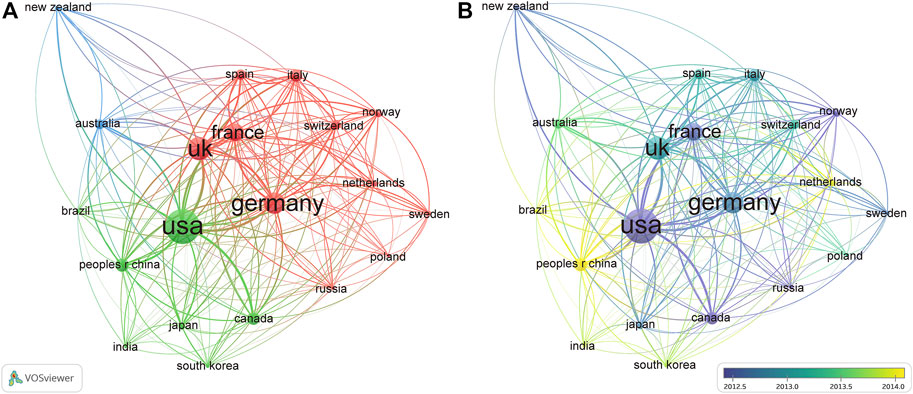
FIGURE 6. Co-authorship among top 21 most productive countries. (A), network visualization; (B), overlay visualization.
Based on the addresses of the authors in this field, 1,037 research institutions are involved. The top 20 most productive institutions over the entire 20 years are listed in Table 4. As shown in Table 4, as many as four of the top institutions in submarine landslide research are from the United States, accounting for 22% of the total articles from the top active institutions. The remaining institutions are from nine countries: France (3), China (1), Germany (3), Italy (1), Spain (1), the United Kingdom (2), Switzerland (1), Russia (1), and Canada (3), with a clear dominance of European institutions. France’s Centre Nation De La Recherche Scientifique was the most productive institution, with 425 publications, followed by the Chinese Academy of Sciences (204) and Germany’s Helmholtz Association (202). The highest average citation per publication is from the University of Southampton (United Kingdom).
From 2001 to 2020, 21,921 authors are involved in the submarine landslides-related study. Table 5 shows the top 20 most productive authors, who are the most important contributors in this field. These authors are from 10 countries, and as many as six of the top authors are from the United Kingdom. Top authors from Germany (3), Spain (2), China (1), Italy (2), France (2), Switzerland (1), Canada (1), Belgium (1), and Norway (1) rank behind the United Kingdom. Talling PJ from Durham University contributes 43 publications to the submarine landslide field, followed by Alves TM (37) from Cardiff University and Masson DG (33) from the University of Southampton, who are all from the United Kingdom. Alves TM (12) contributed the most publications as first author and corresponding author (FP(RP)), followed by Mitchell DG (10) from the University of Manchester and Talling PJ (9). The average citation of the first author and corresponding author publications (FC(RC)/FP(RP)) can be used to evaluate the academic impact of the authors (Wu et al., 2015). In this paper, we calculated this ratio expressed as total citations of the first author and corresponding author per total publications of the first author and corresponding author. Masson DG and Talling PJ rank in first and second place with an FC(RC)/FP(RP) of 183.40 and 165.00, respectively, in academic impact (Table 5), indicating that the two authors have the most high-quality submarine landslide-related articles. Of course, this statistical result is only based on the statistical data of the paper, and the analysis does not consider the position of the authors, whether they are retired, and the situation of mutual research cooperation. We apologize for any possible injustice that this may cause.
To improve the understanding of the research hotspots and trends of a certain research field in a certain period, a quantitative analysis of article titles, abstracts, and keywords is often considered. In this subsection, we analyze the keywords of the field submarine landslide according to the research information from 2001 to 2020 by CiteSpace software. Figure 7 presents a cluster map of keywords from the publications. To generate clusters, we used the keywords’ metadata in CiteSpace. After running the program, the document keywords network identified 978 nodes connected by 1,352 citation likes. Each node in the document citation network is an individual reference/document. We found 28 clusters with modularity (Q = 0.8589) and mean silhouette (S = 0.9473). Generally, the modularity Q and the silhouette S act as important indicators of the cluster panoramic network. Each cluster homogeneity is determined by a Q score that ranges from 0 to 1; the silhouette S score is from −1 to 1 (Chen et al., 2010). High Q indicates a well-structured network, and S equal to 1 indicates a perfect separation from other clusters. Therefore, our results indicate that the clusters network is highly consistent. The areas of different colors indicate the time when co-citation links in those areas appeared for the first time (Chen, 2017). Areas in purple were generated earlier than those in blue (Figure 7). In addition, the clusters are numbered from 0, in order by the cluster size descending (Figure 7; Table 6).
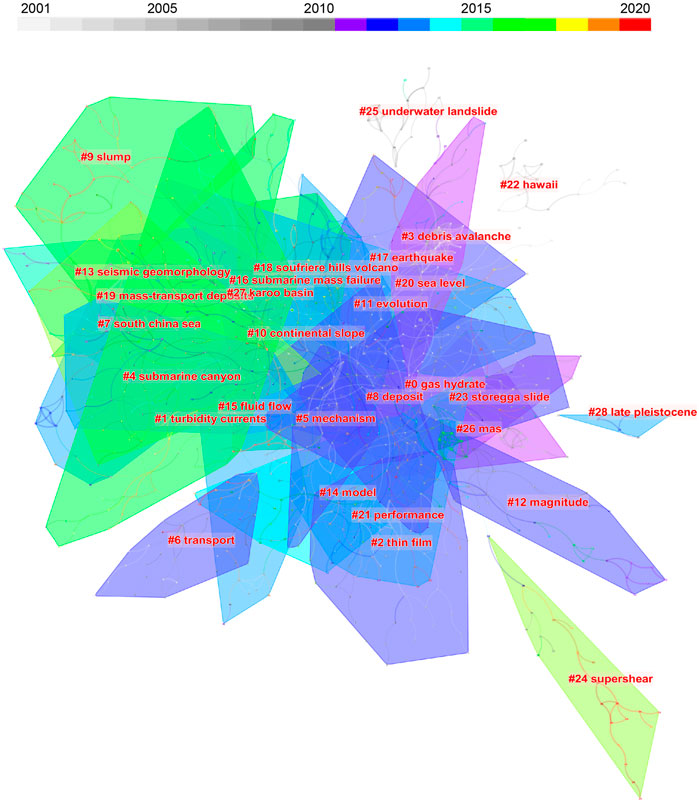
FIGURE 7. A landscape view of keyword cluster network on marine landslides from 2001 to 2020 (LRF = 3, LBY = 5, and e = 1.0), Modularity Q = 0.8589, Weighted Mean Silhouette S = 0.9473, Harmonic Mean (Q, S) = 0.9009.
Figure 7 show how the research on submarine landslides has developed on a global scale in terms of timeline cluster location. A very high correlation among the keyword clusters from submarine landslides is presented in Figure 7, except cluster nos. 22, 24, 25, and 28. The areas of different colors indicate the time when co-citation links in those areas appeared for the first time. The left part of Figure 7 is dominated by green, which indicates the mean years of the clusters are young, and the right part is dominated by blue, which indicates the mean years of the clusters are old.
According to Figures 7, 8, 9; Table 6, we analyzed the cluster results of keywords in the submarine landslides research network to reveal the research situation and research frontiers in the field of submarine landslides. The five largest clusters are as follows: (1) cluster no. 0, labeled “gas hydrate”; (2) cluster no. 1, labeled “turbidity current”; (3) cluster no. 2, labeled “thin film”; (4) cluster no. 3, labeled “debris avalanche”; and (5) cluster no. 4, labeled “submarine canyon.” The five clusters with the strongest citation bursts are as follows: (1) cluster no. 0, labeled “gas hydrate”; (2) cluster no. 13, labeled “seismic geomorphology”; (3) cluster no. 16, labeled “submarine mass failure”; (4) cluster no. 1, labeled “turbidity currents”; and (5) cluster no. 19, labeled “mass-transport deposits.” Clusters no. 3, 10, and 17 are the three oldest clusters; clusters no. 7, 16, and 27 are the three youngest clusters. In terms of activeness, clusters no. 2, 6, 7, 9, 16, 21, 22, 24, and 26 remain active. Cluster no. 16, labeled “submarine mass failure; ” cluster no. 9, labeled “slump; ” and cluster no. 7, labeled “South China Sea,” present the strongest citation bursts among the active clusters.
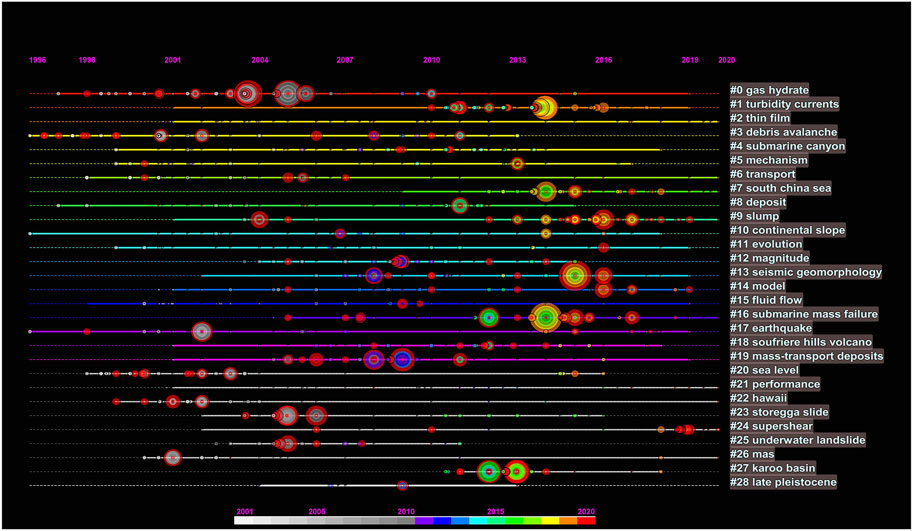
FIGURE 8. A timeline visualization of the 28 keyword clusters from 1996 to 2020 based on 1-year slices. Circles of different diameters highlight references with different citation bursts.
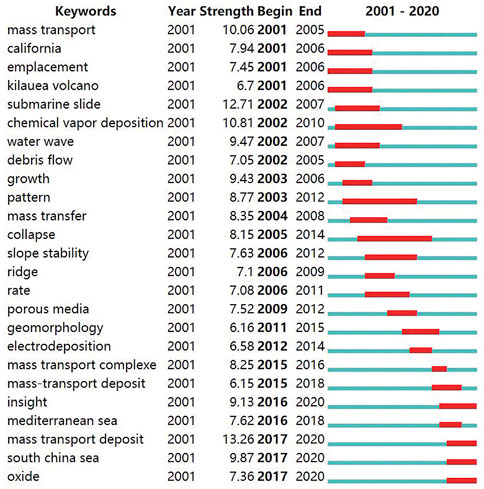
FIGURE 9. Top 25 keywords with the strongest citation bursts of at least 20 years. This figure describes the strength of citation bursts. “Mass-transport deposit,” “submarine slide,” “chemical vapor deposition,” “mass transport,” and “south china sea” are identified as the five keywords with the strongest citation bursts.
Due to the many clusters, and the limitation of the scope and length of the article, our focus narrows to cluster no. 0 labeled “gas hydrate,” cluster no. 1 labeled “turbidity current,” cluster no. 7 labeled “South China Sea,” cluster no. 9 labeled “slump,” and cluster no. 16 labeled “submarine mass failure” to analyze the collected research and propose further research directions. For details on the other clusters, see the cited articles.
Cluster no. 0, labeled “gas hydrate,” is the largest cluster and has 71 members and a silhouette value of 0.94. It contains, for example, gas hydrate, slope stability, sea floor, Gulf of Mexico, and Storegga Slide. The two most actively cited publications reported that gas hydrate and related processes can trigger submarine landslides. Canals published an overview paper to describe and assess eight submarine instabilities. Gas hydrate destabilization or other processes linked to the presence of shallow gas have acted as final triggers of submarine landslides (Canalsa et al., 2004). Haflidason investigated the dating and morphometry of the Storegga Slide (Haflidason et al., 2005). The Storegga Slide is a large submarine landslide that occurred off the coast of southwestern Norway approximately 8,200 years ago and was caused by weak geological layers related to earthquakes or gas and gas hydrates (e.g., Mienert et al., 2003; Bryn et al., 2005). The Storegga Slide, as an important representative of submarine landslides, has been a major hotspot since it appeared in cluster maps in 2005. Its research provides an important reference for other areas of submarine landslide research.
Cluster no. 1, labeled “turbidity current,” has 52 members and a silhouette value of 0.942. It contains, for example, turbidity currents, multibeam bathymetry, cable breaks, sedimentary processes, and contourites. The two most actively cited publications are related to turbidity currents. Active submarine landslides and turbidity currents in the deep ocean can break transoceanic communication cables. Carter researched the causes, frequency, and behavior of damaging submarine flows according to the cable break databases in the Strait of Luzon off southern Taiwan (Carter et al., 2014). Turbidity currents, as an important sediment moving process, play an important role in the burial of organic material and thus in the global carbon cycle (Galy et al., 2007). Talling suggested that understanding the frequency timing and triggers of turbidity currents is important for understanding how sediment is moved globally, the effective recovery of oil and gas reserves, hazards to strategic cable networks, and the recurrence intervals of tsunamis and earthquakes (Talling, 2014).
Cluster no. 7, labeled “South China Sea,” had 35 members and a silhouette value of 0.927. It contains, for example, South China Sea, late Miocene, submarine fan system, triggering mechanism, and Messinian salinity crisis. Actively cited publications emphasized that continental margins and volcano flanks are the main areas where submarine landslides occur. Harbitz answered the questions about why landslide tsunamis are extreme and where landslide sources occur. Particularly notable is that submarine landslides caused many of the historical tsunamis in South and Southeast Asia. The tsunami hazard in Southeast Asia has received substantial attention. Harbitz suggested recurrence intervals, hazards, and uncertainties should be assessed to improve the understanding and hazard assessment of landslide tsunamis (Harbitz et al., 2014). China has conducted many investigations and studies in the South China Sea. High-resolution geophysical data and research results of many submarine landslides on the continental slope of the South China Sea have been obtained. Because these submarine landslides are at risk of sliding again, the focus of ongoing research will be the mechanisms of submarine landslides and their potential to trigger tsunamis (Sun et al., 2020). Sun et al. (2017), one of the actively cited publications, showed that free gas accumulation below mass-transport deposits (MTDs) should be considered an important geohazard in the South China Sea and the continental margins.
Cluster no. 9, labeled “slump,” has 33 members and a silhouette value of 0.966. It contains, for example, slump, dead sea, dead sea basin, mtd, and pore pressure. MTDs are the result of gravity-induced mass failures (slump) occurring on submarine slopes. Kneller et al. (2016), the most actively cited publication, discussed the implications for reservoir location, geometry and facies distribution, and subsurface identification associated with MTDs.
Cluster no. 16, labeled “submarine mass failure,” has 32 members and a silhouette value of 0.951. It contains, for example, submarine mass failure, hazard, tsunamis, uncertainty quantification, and wave. Tappin et al. (2014), the most actively cited publication, discussed whether the 2011 Tohoku tsunami was generated by a “dual source.” Tappin suggested that a submarine landslide and the earthquake contributed to the 2011 Tohoku tsunami (Tappin et al., 2014).
In summary, cluster nos. 0 and cluster 1, the main research directions of submarine landslides, were active from 1997 to 2019 and from 2001 to 2019, respectively. Although they were not active in 2020, those keyword-related studies in the two largest clusters are also found in the three active clusters no. 7, 9, and 16. We predict that the main research frontiers of submarine landslides will focus on the three clusters “south china sea,” “slump,” and “submarine mass failure.” Cluster no. 7, labeled “south china sea,” is a hotspot in research. Cluster no. 9, labeled “slump,” and cluster no. 16, labeled “submarine mass failure,” present research directions related to the economic (energy and ocean engineering) and security (hazard and tsunamis).
This study presented an overview of the global research on submarine landslides from 2001 to 2020 based on scientometrics analysis, including document types, publishing languages, subject categories, journals, the productivity of countries and authors, and co-occurrence keywords.
From 2001 to 2020, publications and citations on submarine landslides increased with an average annual rate of 7.5% and 24%, respectively. A total of 5,831 publications were listed in 75 WoS categories and 1,080 journals from 2001 to 2020. Geoscience multidisciplinary, Geochemistry Geophysics, Oceanography, Environmental Sciences, and Material Science Multidisciplinary are five often observed science categories, which show trends of increasingly extensive disciplines and steady growth. In addition, Marine Geology, Marine and Petroleum Geology, Journal of Volcanology, and Geothermal Research are the most productive journals on submarine landslides. Furthermore, Marine Geology plays an important role in the bibliography coupling network. That finding implies that the studies on submarine landslides increased in importance and complexity in global research.
The number of countries and institutions that have participated in submarine landslide studies is 126 and 1,037, respectively. The most productive countries are the United States, the United Kingdom, China, Germany, and France. Three clusters identified to have the strongest academic performance were located in North America, Europe, and Asia, indicating that international cooperation in conducting research on a global scale in the submarine landslide field is increasing. The most prolific institution is Centre Nation De La Recherche Scientifique (France), followed by the Chinese Academy of Sciences (China). From 2001 to 2020, 21,921 authors have been involved in submarine landslide studies. The academic impact of the authors was evaluated by TP, FP(RP), and the ratio of FC(RC)to FP(RP). Masson DG and Talling PJ contributed the most publications and possessed high-quality publications.
The research status and further research directions of submarine landslides are as follows: clusters “gas hydrate,” “turbidity current,” “thin film,” “debris avalanche,” and “submarine canyon” are the five largest clusters in the submarine landslide field when using CiteSpace; the three clusters “south china sea,” “slump,” and “submarine mass failure” are the main active research frontiers of submarine landslides.
Publicly available datasets were analyzed in this study. This data can be found here: https://www.webofscience.com/wos/alldb/basic-search.
WC wrote the manuscript and draw the figures. JX provided the ideas and wrote the manuscript.
This research was supported by the National Natural Science Foundation of China (Nos. 42076224 and 91858215).
The authors declare that the research was conducted in the absence of any commercial or financial relationships that could be construed as a potential conflict of interest.
The handling editor XL declared a shared affiliation with the author JX at the time of review.
All claims expressed in this article are solely those of the authors and do not necessarily represent those of their affiliated organizations, or those of the publisher, the editors and the reviewers. Any product that may be evaluated in this article, or claim that may be made by its manufacturer, is not guaranteed or endorsed by the publisher.
Bryn, P., Berg, K., Forsberg, C. F., Solheim, A., and Kvalstad, T. J. (2005). Explaining the Storegga slide. Mar. Petroleum Geol. 22 (1-2), 11–19. doi:10.1016/j.marpetgeo.2004.12.003
Canalsa, M., Lastrasa, G., Urgelesa, R., Casamora, J. L., Mienertb, J., Cattaneoc, A., et al. (2004). Slope failure dynamics and impacts from seafloor and shallow sub-seafloor geophysical data: Case studies from the COSTA project. Mar. Geol. 213, 9–72. doi:10.1016/j.margeo.2004.10.001
Carter, L., Gavey, R., Talling, P. J., and Liu, J. T. (2014). Insights into submarine geohazards from breaks in subsea telecommunication cables. Oceanography 27 (2), 58–67. doi:10.5670/oceanog.2014.40
Chen, C., Ibekwe-SanJuan, F., and Hou, J. (2010). The structure and dynamics of cocitation clusters: A multiple-perspective cocitation analysis. J Am Soc Inf Sci. Technol. 61 (7), 1386–1409. doi:10.1002/asi.21309
Chen, C. (2017). Science mapping: A systematic review of the literature. J. Data Inf. Sci. 2 (2), 1–40. doi:10.1515/jdis-2017-0006
Chen, C. (2004). Searching for intellectual turning points: Progressive knowledge domain visualization. Process. Natl. Acad. Sci. U. S. A. 101, 5303–5310. doi:10.1073/pnas.0307513100
Fan, J. L., Shen, S., Wang, J. D., Wei, S. H., Zhang, X., Zhong, P., et al. (2020). Scientific and technological power and international cooperation in the field of natural hazards: A bibliometric analysis. Nat. Hazards 102, 807–827. doi:10.1007/s11069-020-03919-8
Fu, L., Heidarzadeh, M., Cukur, D., Chiocci, F. L., Ridente, D., Gross, F., et al. (2017). Tsunamigenic potential of a newly discovered active fault zone in the outer Messina Strait, Southern Italy. Geophys. Res. Lett. 44 (5), 2427–2435. doi:10.1002/2017gl072647
Galy, V., France-Lanord, C., Beyssac, O., Faure, P., Kudrass, H., and Palhol, F. (2007). Efficient organic carbon burial in the Bengal fan sustained by the Himalayan erosional system. Nature 450, 407–410. doi:10.1038/nature06273
Gizzi, F. T., and Leucci, G. (2018). Global research patterns on ground penetrating radar (GPR). Surv. Geophys. 39 (6), 1039–1068. doi:10.1007/s10712-018-9475-1
Gokceoglu, G., and Sezer, E. A. (2009). A statistical assessment on international landslide literature (1945–2008). Landsildes 6, 345–351. doi:10.1007/s10346-009-0166-3
Haflidason, H., Lien, R., Sejrup, H. P., Forsberg, C. F., and Bryn, P. (2005). The dating and morphometry of the Storegga Slide. Mar. Petroleum Geol. 22, 123–136. doi:10.1016/j.marpetgeo.2004.10.008
Hampton, M. A., Lee, H. J., and Locat, J. (1996). Submarine landslides. Rev. Geophys. 34 (1), 33–59. doi:10.1029/95rg03287
Harbitz, C. B., Løvholt, F., and Bungum, H. (2014). Submarine landslide tsunamis: How extreme and how likely? Nat. Hazards 72, 1341–1374. doi:10.1007/s11069-013-0681-3
Heidarzadeh, M., Krastel, S., and Yalciner, A. C. (2014). “The state-of-the-art numerical tools for modeling landslide tsunamis: A short review,” in Submarine mass movements and their consequences (Springer International publishing), 483–495.
Hu, Z. G., and Zhang, C. Z. (2021). The quiet rise of bibliometrics based on full text. Libr. Trib. 41 (3), 1–11.
Kneller, B., Dykstra, M., Fairweather, L., and Milana, J. P. (2016). Mass-transport and slope accommodation: Implications for turbidite sandstone reservoirs. AAPG Bull. 100, 213–235. doi:10.1306/09011514210
Li, Q. (2017). Research hotspots of karst in 2016 based on bibliometrics analysis. Adv. Earth Sci. 32 (5), 535–545. doi:10.11867/j.issn.1001-8166.2017.05
Locat, J., and Lee, H. J. (2002). Submarine landslides: Advances and challenges. Can. Geotechnical J. 39 (1), 193–212. doi:10.1139/t01-089
Masson, D. G., Harbitz, C. B., Wynn, R. B., Pedersen, G., and Løvholt, F. (2006). Submarine landslides: Processes, triggers and hazard prediction. Philosophical Trans. R. Soc. A Math. Phys. Eng. Sci. 364, 2009–2039. doi:10.1098/rsta.2006.1810
Mienert, J., Andreassen, K., and Bünz, S. (2003). Gas hydrates at Storegga slide. Springer Berlin Heidelberg, 107–110.
Mountjoy, J., and Micallef, A. (2018). “Submarine landslides,” in Submarine geomorphology. Editor A. Micallef (Cham: Springer), 235–250. doi:10.1007/978-3-319-57852-1_13
Sassa, K., Tsuchiya, S., Fukuoka, H., Mikos, M., and Doan, L. (2015). Landslides: Review of achievements in the second 5-year period (2009–2013). Landsildes 12, 213–223. doi:10.1007/s10346-015-0567-4
Sun, Q. L., Alves, T., Xie, X. N., He, J. X., Li, W., and Ni, X. L. (2017). Free gas accumulations in basal shear zones of mass-transport deposits (Pearl River Mouth Basin, South China Sea): An important geohazard on continental slope basins. Mar. Petroleum Geol. 81, 17–32. doi:10.1016/j.marpetgeo.2016.12.029
Sun, Q. L., Xie, X. N., and Wu, S. G. (2020). Submarine landslides in the northern South China Sea: Characteristics, geohazard evaluation and perspective. Earth Sci. Front. doi:10.13745/j.esf.sf.2020.9.3
Talling, P. J. (2014). On the triggers, resulting flow types and frequencies of subaqueous sediment density flows in different settings. Mar. Geol. 352, 155–182. doi:10.1016/j.margeo.2014.02.006
Tappin, D. R., Grilli, S. T., Harris, J. C., Geller, R. J., Masterlark, T., Kirby, J. T., et al. (2014). Did a submarine landslide contribute to the 2011 Tohoku tsunami? Mar. Geol. 357, 344–361. doi:10.1016/j.margeo.2014.09.043
van Eck, N. J., and Waltman, L. (2007). Bibliometric mapping of the computational intelligence field. Int. J. Uncertain. Fuzziness Knowledge-Based Syst. 15 (5), 625–645. doi:10.1142/s0218488507004911
Wu, S. G., Ma, L. W., Sun, J., Guo, Y. B., Zhang, G. W., Zhao, S. W., et al. (2021). Characteristic and current status of some large-scale geological disasters along the Maritime Silk Road. Prog. Geophys. 36 (1), 401–411.
Wu, X. L., Chen, X. Y., Zhan, F. B., and Hong, S. (2015). Global research trends in landslides during 1991–2014: A bibliometric analysis. Landsildes 12, 1215–1226. doi:10.1007/s10346-015-0624-z
Ye, Y. (2017). “Submarine landslides,” in Marine geo-hazards in China (Wiley), 179–267. doi:10.1016/B978-0-12-812726-1.00006-1
Zhang, C. Y., Yu, W. Y., Wang, L., and Feng, Z. G. (2016). Bibliometric analysis on trench research output. Stud. Mar. Sin. 51, 308–320.
Zhu, C. Q., Jia, Y. G., Liu, X. L., Zhang, H., Wen, M. Z., Huang, M., et al. (2015). Classification and genetic mechanism of submarine landslide: A review. Mar. Geol. Quat. Geol. 35 (6), 153–163.
Keywords: submarine landslides, bibliometric, VOSviewer, citespace, disaster
Citation: Chen W and Xing J (2023) Global research on submarine landslides, 2001–2020. Front. Earth Sci. 11:982482. doi: 10.3389/feart.2023.982482
Received: 30 June 2022; Accepted: 22 March 2023;
Published: 04 April 2023.
Edited by:
Xiting Liu, Ocean University of China, ChinaReviewed by:
Lingxin Chen, Yantai Institute of Coastal Zone Research (CAS), ChinaCopyright © 2023 Chen and Xing. This is an open-access article distributed under the terms of the Creative Commons Attribution License (CC BY). The use, distribution or reproduction in other forums is permitted, provided the original author(s) and the copyright owner(s) are credited and that the original publication in this journal is cited, in accordance with accepted academic practice. No use, distribution or reproduction is permitted which does not comply with these terms.
*Correspondence: Junhui Xing, anVuaHVpeGluZ0BvdWMuZWR1LmNu
Disclaimer: All claims expressed in this article are solely those of the authors and do not necessarily represent those of their affiliated organizations, or those of the publisher, the editors and the reviewers. Any product that may be evaluated in this article or claim that may be made by its manufacturer is not guaranteed or endorsed by the publisher.
Research integrity at Frontiers

Learn more about the work of our research integrity team to safeguard the quality of each article we publish.